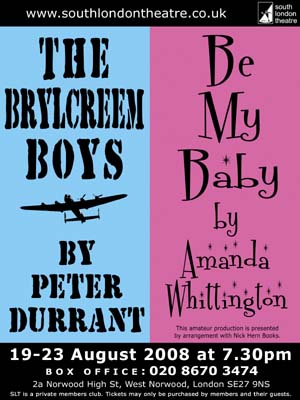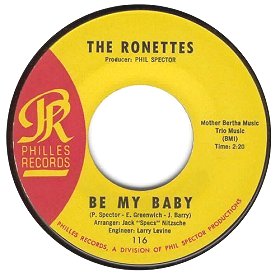Be My Baby (2008)

Performances: Tuesday 19 to Saturday 23 August 2008, Prompt Corner, at 7.30pm
Double bill with The Brylcreem Boys
Contents
Introduction
The night we met I knew I needed you so
And if I had the chance I'd never let you go
So won't you say you love me
I'll make you so proud of me
We'll make them turn their heads every place we go ♥
In 1964 heads would certainly have been turning (and the net curtains twitching) for Mary, Queenie and many more like them.
Well before the Abortion Act of 1967 and the widespread availability of the contraceptive pill, becoming pregnant was a very real risk for sexually active women, many shockingly ill-informed about their bodies and the possible consequences.
Be My Baby tells the stories of four young women in St Saviour's, a church run "mother and baby" home somewhere in a remote part of England. Women come here to hide from the public gaze until the birth of their babies, which are then handed over for adoption, whether they like it or not.
Mary is a new arrival at the home, nineteen years old and seven months pregnant. This may not be the brutal environment of the notorious Magadalen Laundries, but Mary and the other inmates work hard for their keep, frightened and alone far away from the home and family that they so desperately need at this moment in their young lives. As the time of the birth approaches Mary's plans to escape the trap she finds herself in and bring up her baby herself are thwarted by the harsh realities of the era.
The only solace the girls find is in the the cameraderie of others in the same predicament and through the girl group songs in Mary's record collection. The glorious sounds of The Ronettes, The Dixie Cups, The Shangri-Las and a host of others add a bittersweet soundtrack of teenage love, longing and idealised happy endings to this heartbreaking drama.
Whether Mary and the others end up going to the chapel, gonna get married, you'll have to come and see. With six substantial parts for women played by a strong cast of new and familiar SLT faces, this will certainly be an evening to remember.
♥ Be My Baby written by Phil Spector, Ellie Greenwich & Jeff Barry
Cast
- Mary - Kat Madriaga
- Queenie - Ruth Huggett
- Norma - Suzanne Morgan
- Dolores - Sinéad O'Neill
- Mrs Adams - Jan Horne
- Matron - Vanessa Colls
Crew and other assistance
- Stage Manager - Graham Clements
- Lighting design - Induja Bandara
- Sound design and operation - Kevin Leech
- Lighting operation - Jenny Harris
- Assistant Stage Managers - James Hough and Christina Andrews
- Costumes, bump maker, pregnancy advice and camouflage hairdo construction - Val Williams
- Props - Alan Buckman, Phil and Jenny Gammon, Mark Ireson and cast
- Baby juggling and gory stories about childbirth - Samantha Golton (with the invaluable practical assistance of Beatrice Scholes, aged 9 weeks)
- The editor and staff of The Lady magazine for raiding their archives when not even eBay could produce a single vintage copy
Reviews
Some review quotes go here
Gallery
Here is Phil Gammon's gallery of production photos
Reminiscences and Anecdotes
Members are encouraged to write about their experiences of working on or seeing this production. Please leave your name. Anonymous entries may be deleted.
See Also
Have there been other SLT productions of this play? Link to them here.
Or add anything that is related within this site. The author's page for instance or other plays with a similar theme.
Music
The girl group songs of the early 1960s play an integral part in the action of the play. The script calls for the use of four specific songs, while several others are used during scene changes and as play-in music. You can listen to all the songs used in the production here
The songs specified in the script are:
- Be My Baby by The Ronettes
- Chapel Of Love by The Dixie Cups
- Past, Present And Future by The Shangri-Las
- So Young by Veronica
Other songs used in the production are a mix of the well known and the fairly obscure:
- Cause I Love Him by Alder Ray
- Third Finger, Left Hand by Martha & The Vandellas
- Did You Get Your Fun by The Bootiques
- I Wanna Love Him So Bad by The Jelly Beans
- Give Us Your Blessings by The Shangri-Las
- Please Mr Postman by The Marvelettes
- The One You Can't Have by The Honeys
- One Boy Tells Another by The Surfer Girls
- That New Boy In Town by Jan Tanzy
- Jilted by The Goodees
- You Don't Have To Say You Love Me by Dusty Springfield
- You Don't Know by Ellie Greenwich
- When The Boy's Happy (The Girl's Happy Too) by The Four Pennies
Most of these were found on the Rhino Records 4 CD set One Kiss Can Lead To Another: Girl Group Sounds Lost & Found or the Ace Records Where The Girls Are series. The songs that were listened to but didn't make the cut would fill a fair sized iPod.
If you're interested in finding out more about girl groups, Phil Spector's Wall of Sound and other music from the Brill Building era, Spectropop and GirlGroup.com are good places to start.
